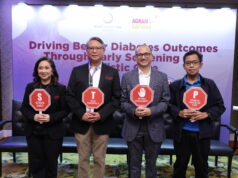Medicine Cabinet
Reiner W. Gloor
MARCH is still International Women’s Month and to continue our discussion on health issues plaguing women today, we’d like to focus on two cancers: breast and cervical. Both these cancers are the leading causes of death among women in the Philippines and the statistics are alarming.
Approximately 16% of all cancer cases are breast cancer. Reports show that the Philippines has the highest incidence rate in Asia and is among the top 10 countries with the most cases of breast cancer. It is estimated that three out of 100 Filipino women will develop the disease before age 75, with one out of 100 dying of this before age 75. These are results published by the Philippine Society of Medical Oncology magazine in 2012.
The Department of Health (DoH) and the Philippine Cancer Society have both stated that breast cancer is the most common cancer in the country, accounting for 28% of total cases. One out of four women diagnosed with breast cancer will die within the first five years, and no less than 40% will die within 10. Researchers have not been able to point out why Filipinas are especially susceptible.
However, medical experts insist women have a greater chance of surviving breast cancer if it is caught early. Self-breast exams (SBE) are key and many guides can be found online. SBEs should be done regularly so any symptoms can be caught. The most common signs are lumps or masses in the breast but there are others such as nipple discharge or redness, breast or nipple pain, swelling or dimpling in parts of the breast. It is also important for women over 40 to have a mammogram every year. For ladies in their 20s and 30s, the monthly SBEs can be done on top of clinical breast exams performed during regular health screenings by a health care professional every three years.
It is also important to be aware of the factors that add to the risk of a woman getting breast cancer. While family history accounts for approximately 7% of all breast cancers, the risk increases even more if relatives were affected by the disease before menopause. Probably causes also include: having a first child after the age of 30, not having a child at all, late menopause, early start of menstruation, and benign breast disease. The following are also causes for concern though they have not been proven conclusively to cause breast cancer: use of oral contraceptives, long-term estrogen replacement therapy, alcohol use, and obesity.
The DoH also reports that next to breast cancer, cervical cancer is the second leading cause of death among women, half of them aged 35 to 55 years old. It is caused by the human papilloma virus (HPV) which is a common virus that can occur in both men and women, and some types develop into cancer.
Possible causes of cervical cancer include: disorders that weaken the immune system like HIV/AIDS, intercourse at an early age, having multiple sexual partners, having a sexual partner infected with HPV, multiple pregnancies, and smoking.
Cervical cancer does not have definite symptoms so health experts suggest that women have regular pap smears and undergo HPV vaccination (one shot for two consecutive months and the third after six months). Once in its advance stage, these are just some of what women may experience: unpleasant vaginal discharge; pain during and bleeding after intercourse; bleeding after menopause; bleeding from the rectum, anemia; pelvic, leg and back pain; urinary problems; and weight loss.
As an answer to the growing burden of both these cancers, the Philippine Health Insurance Corp. (PhilHealth) is being requested to consider covering diagnostic services for breast and cervical cancer. Filed under House Bill No. 6249 by Quezon City Representative Alfredo D. Vargas III (5th District), the Breast and Cervical Cancer Protection Act provides the inclusion of periodic diagnostic services for breast and cervical cancer in the benefit package of the national health insurance corporation. The measure provides that the mandatory diagnostic exams be done once a year or as often as necessary as determined by the DoH.
PhilHealth currently covers breast and cervical cancer treatments under its Z Benefit Package. Breast cancer stages 0 to IIIA, cervical cancer stages IA1, IA2-IIA1 are covered. For complete information on PhilHealth benefits, visit philhealth.gov.ph/benefits.
I also urge you to talk to your primary care physician about HPV vaccines, especially if you have daughters between nine and 26 years of age. And there are many hospitals now in the Philippines with dedicated breast centers, specializing in breast cancer: St. Luke’s, Makati Medical Center, Asian Hospital and Medical Center, the East Avenue Medical Center, the National Kidney and Transplant Institute are just a few.
It would be great if we can encourage the women in our lives to be aware of the risk factors and help them to better health.
Log on to www.phap.org.ph and www.phapcares.org.ph. E-mail the author at reiner.gloor@gmail.com.



